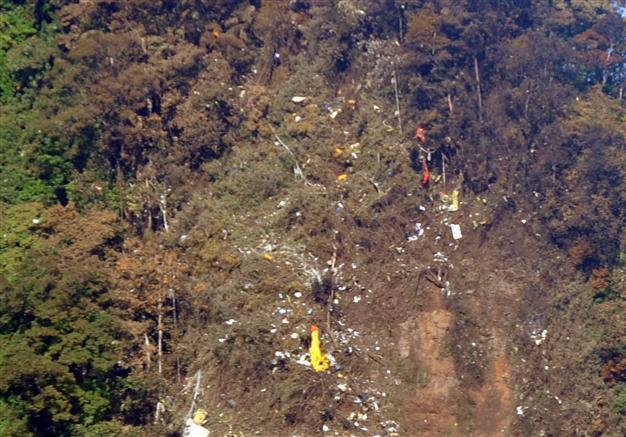Indonesian rescuers find 12 bodies at jet crash site
JAKARTA - Agence France-Presse

This picture taken from Salak Peak 3 Cijeruk, Bogor on May 11, 2012 shows the wreckage of the Russian Shukoi Superjet 100 plane crash. AFP Photo
Indonesian rescuers today found the bodies of 12 of the people killed when their Russian jet crashed into the face of a mountain during a sales flight.
Questions mounted over how the twin-engine Sukhoi Superjet 100, a new passenger plane with a veteran pilot at the controls, crashed into Mount Salak, a dormant volcano well-known to pilots as a peril.
Rescuers struggled to reach the jungly site on the face of the mountain, using climbing equipment to ascend the near-vertical slope where bodies and debris were scattered.
"Today we reached the crash site... and we found 12 victims and they were all dead. We will continue the evacuation process," said Daryatmo, head of the national search and rescue agency, who goes by one name.
"I still don't know the condition of the bodies, but we haven't been able to evacuate them. The bodies are still in body bags," he told reporters in Jakarta.
Marine Lieutenant Colonel Oni Junianto, who was helping to oversee the rescue effort, told AFP that the bodies were identifiable.
"There are no signs they were burnt," he said.
A rescuer returning from the site said he witnessed haunting scenes of torn bodies and limbs that were put inside body bags.
Once retrieved, bodies and remains will be taken by helicopter to Jakarta where authorities have conducted DNA tests on relatives to proceed with the identification process.
The difficult terrain, which most days is shrouded in thick fog, has been an extreme challenge to the searchers and stopped helicopters from getting close to the crash site, which is at an elevation of 5,900 feet (1,800 metres).
All aboard the aircraft were killed, authorities said Thursday, a day after the plane disappeared from radar screens during a promotional flight that was meant to spur international sales of
Russia's first post-Soviet civilian jet.
The company representing Sukhoi in
Indonesia, Trimarga Rekatama, originally said 50 passengers were on board but revised the number down to 45. Local rescue officials said the plane was carrying 46 people.
The passenger aircraft descended from 10,000 feet (3,000 metres) to 6,000 feet before slamming into Mount Salak, which juts 7,200 feet into the sky south of Jakarta, authorities said.
Controversy swirled over why the 57-year-old, vastly experienced Russian captain descended so low over mountainous terrain. Others questioned whether the jet, which had already experienced some troubles while being flown by Russia's Aeroflot, encountered an unknown emergency in a tricky air corridor.
"Why did the Sukhoi descend, and who cleared it?" said a headline in the English-language Jakarta Post. Authorities have only confirmed that the plane descended, without saying whether it was cleared by air traffic control.
The authorities will be keen to locate the plane's black boxes, which may help to resolve the unanswered questions.
Wednesday's calamity came 50 minutes into a brief flight that was part of an Asian sales tour to promote the aircraft, a joint venture between Sukhoi and Italy's Alenia Aeronautica, which made its first commercial flight last year.
Gerry Soejatman, an aviation consultant and amateur pilot who is familiar with the airspace around Mount Salak, said it was not the place for an exhibition flight.
"I don't recommend the area around Mount Salak for a low-level flight, especially for someone who's never flown in the area," he told AFP.
"Very few pilots would actually fly around there without any particular purpose, because of the pass between the mountains, which is open to fast-changing weather conditions," he said.
In Moscow, investigators have opened a criminal probe to look into possible misconduct during preparations for the flight.
The loss of the Superjet is a heavy blow to the Russian aviation industry, which was hoping that the new plane would improve its image.
Those aboard were mostly Indonesian aviation representatives, but there were also eight Russians -- four of them crew and four Sukhoi employees -- plus an American and a Frenchman, officials said.
